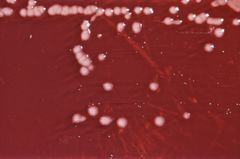Pseudomonas dermatitis: Difference between revisions
No edit summary |
m (Robot: Changing Category:DiseaseState to Category:Disease) |
||
| Line 36: | Line 36: | ||
The content on this page was first contributed by: [[C. Michael Gibson]], M.S., M.D. | The content on this page was first contributed by: [[C. Michael Gibson]], M.S., M.D. | ||
{{SIB}} | {{SIB}} | ||
{{WH}} | {{WH}} | ||
{{WS}} | {{WS}} | ||
[[Category:Disease]] | |||
[[Category:Infectious disease]] | |||
Revision as of 18:20, 12 December 2011

Editor-In-Chief: C. Michael Gibson, M.S., M.D. [1]
Please Take Over This Page and Apply to be Editor-In-Chief for this topic: There can be one or more than one Editor-In-Chief. You may also apply to be an Associate Editor-In-Chief of one of the subtopics below. Please mail us [2] to indicate your interest in serving either as an Editor-In-Chief of the entire topic or as an Associate Editor-In-Chief for a subtopic. Please be sure to attach your CV and or biographical sketch.
Related Key Words and Synonyms: Hot tub rash
Overview
Hot Tub Rash or dermatitis is an infection of the skin. The skin may become itchy and progress to a bumpy red rash that may become tender. There may also be pus-filled blisters that are usually found surrounding hair follicles. Because a swimsuit can keep contaminated water in longer contact with the skin, the rash may be worse under a person’s swimsuit.
Pathophysiology & Etiology
Hot tub rash infections are often caused by the germ Pseudomonas aeruginosa.
This germ is common in the environment (water, soil) and is microscopic so that it can’t be seen with the naked eye. Most rashes clear up in a few days without medical treatment. However, if your rash persists, consult your healthcare provider.
Hot Tub Rash is spread by direct skin contact with contaminated water. The rash usually occurs within a few days of swimming in poorly maintained hot tubs or spas but can also be spread by swimming in a contaminated pool or lake.
Skin
The skin may become itchy and progress to a bumpy red rash that may become tender. There may also be pus-filled blisters that are usually found surrounding hair follicles.
Primary Prevention
Be aware that hot tubs and spas have warmer water than pools, so chlorine or other disinfectants break down faster. This leaves hot tubs and spas at risk for the spread of RWIs. Therefore, ask your pool manager about the disinfectant and pH testing program at your hot tub or pool.
Ensuring frequent testing, control of disinfectant (usually chlorine or bromine) levels, and pH control are likely to prevent the spread of dermatitis.
References
Acknowledgements
The content on this page was first contributed by: C. Michael Gibson, M.S., M.D. Template:SIB